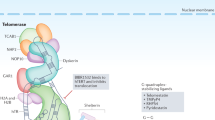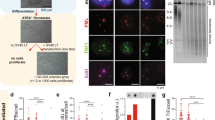Abstract
Telomerase activity in tumours is often associated with p53 mutation. Many antitelomerase therapies take advantage of the inability of cells expressing mutant p53 to undergo replicative senescence, since this allows telomere erosion to continue until ‘crisis’, hence providing the desired cytotoxic effect. However, some tumour types, including breast, melanomas and thyroid, retain wild-type p53 function and the effectiveness of antitelomerase therapies in such tumour cells have not been adequately addressed. To explore this, we made use of two thyroid cancer cell lines K1 and K2, which retain wt p53. Telomere erosion induced by the expression of a dominant-negative (DN) hTERT resulted in delayed onset of growth arrest in K1 and K2 cells, reminiscent of replicative senescence, with low levels of BrdU labelling and apoptosis, associated with high p21WAF1 and senescence-associated β galactosidase expression. In contrast, abrogation of p53 function by the expression of HPV16 E6 in K1 and K2 cells either at the same time as DNhTERT or just prior to the onset of senescence allowed cells to continue growing until ‘crisis’. Likewise, microinjection of a p53 neutralizing antibody into ‘senescent’ K1 DNhTERT cells permitted re-entry into the cell cycle. We conclude that thyroid tumour cells with wild-type p53 retain an intact p53-mediated growth arrest response to telomere erosion. This raises the intriguing question of why, therefore, p53 mutation is not selected for in such cancers, and also calls into question the therapeutic value of telomerase inhibitors in such cases.
This is a preview of subscription content, access via your institution
Access options
Subscribe to this journal
Receive 50 print issues and online access
$259.00 per year
only $5.18 per issue
Buy this article
- Purchase on Springer Link
- Instant access to full article PDF
Prices may be subject to local taxes which are calculated during checkout








Similar content being viewed by others
References
Balint EE and Vousden KH . (2001). Br. J. Cancer, 85, 1813–1823.
Bond JA, Blaydes JP, Rowson J, Haughton MF, Smith JR, Wynford-Thomas D and Wyllie FS . (1995). Cancer Res., 55, 2404–2409.
Bond JA, Haughton MF, Rowson JM, Smith PJ, Gire V, Wynford-Thomas D and Wyllie FS . (1999). Mol. Cell Biol., 19, 3103–3114.
Bond JA, Oddweig Ness G, Rowson J, Ivan M, White D and Wynford-Thomas D . (1996). Int. J. Cancer, 67, 563–572.
Brousset P, Chaouche N, Leprat F, Branet-Brousset F, Trouette H, Zenou RC, Merlio JP and Delsol G . (1997). J. Clin. Endocrinol. Metab., 82, 4214–4216.
Crook T, Nicholls JM, Brooks L, O'Nions J and Allday MJ . (2000). Oncogene., 19, 3439–3444.
Davis T, Singhrao SK, Wyllie FS, Haughton MF, Smith PJ, Wiltshire M, Wynford-Thomas D, Jones CJ, Faragher RG and Kipling D . (2003). J. Cell Sci., 116, 1349–1357.
Delhommeau F, Thierry A, Feneux D, Lauret E, Leclercq E, Courtier MH, Sainteny F, Vainchenker W and Bennaceur-Griscelli A . (2002). Oncogene, 21, 8262–8271.
Dimri GP, Lee X, Basile G, Acosta M, Scott G, Roskelley C, Medrano EE, Linskens M, Rubelj I, Pereira-Smith O, Peacocke M and Campisi J . (1995). Proc. Natl. Acad. Sci. USA, 92, 9363–9367.
Florenes VA, Oyjord T, Holm R, Skrede M, Borresen AL, Nesland JM and Fodstad O . (1994). Br. J. Cancer, 69, 253–259.
Gire V and Wynford-Thomas D . (1998). Mol. Cell Biol., 18, 1611–1621.
Goldman MA . (2003). Drug Disc. Today, 8, 294–296.
Granger MP, Wright WE and Shay JW . (2002). Crit. Rev. Oncol. Hematol., 41, 29–40.
Hahn WC, Stewart SA, Brooks MW, York SG, Eaton E, Kurachi A, Beijersbergen RL, Knoll JH, Meyerson M and Weinberg RA . (1999). Nat. Med., 5, 1164–1170.
Hudson JD, Shoaibi MA, Maestro R, Carnero A, Hannon GJ and Beach DH . (1999). J. Exp. Med., 190, 1375–1382.
Jones CJ, Shaw JJ, Wyllie FS, Gaillard N, Schlumberger M and Wynford-Thomas D . (1996). Mol. Cell Endocrinol., 116, 115–119.
Jones CJ, Soley A, Skinner JW, Gupta J, Haughton MF, Wyllie FS, Schlumberger M, Bacchetti S and Wynford-Thomas D . (1998). Exp. Cell Res., 240, 333–339.
Lubbe J, Reichel M, Burg G and Kleihues P . (1994). J. Invest. Dermatol., 102, 819–821.
Matthews P, Jones CJ, Skinner J, Haughton M, de Micco C and Wynford-Thomas D . (2001). J. Pathol., 194, 183–193.
Pharoah PD, Day NE and Caldas C . (1999). Br. J. Cancer, 80, 1968–1973.
Saretzki G . (2003). Cancer Lett., 194, 209–219.
Shay JW, Wright WE, Brasiskyte D and Van der Haegen BA . (1993). Oncogene, 8, 1407–1413.
Soares P, Trovisco V, Rocha A, Lima J, Castro P, Preto A, Maximo V, Botelho T, Seruca R and Sobhrinho-Simoes M . (2003). Oncogene, 22, 4578–4580.
Soussi T . (2000). Ann. NY Acad. Sci., 910, 121–137.
Vojtesek B, Bartek J, Midgley CA and Lane DP . (1992). J. Immunol. Methods, 151, 237–244.
Webley K, Bond JA, Jones CJ, Blaydes JP, Craig A, Hupp T and Wynford-Thomas D . (2000). Mol. Cell Biol., 20, 2803–2808.
Wyllie FS, Haughton MF, Blaydes JP, Schlumberger M and Wynford-Thomas D . (1995). Oncogene, 10, 49–59.
Wyllie FS, Haughton MF, Rowson JM and Wynford-Thomas D . (1999). Br. J. Cancer, 79, 1111–1120.
Wynford-Thomas D and Blaydes J . (1998). Carcinogenesis, 19, 29–36.
Wynford-Thomas D . (1997). Horm. Res., 47, 145–157.
Acknowledgements
This work was supported by a Cancer Research UK programme grant to DW-T and DK. AP was supported by a studentship from the Portuguese Science and Technology Foundation (FCT; ref: PRAXIS XXI/BD/21795/99 – AP) with further funding from the same source (project POCTI/CBO/41084/2001). We thank Robert Weinberg and William Hahn for DNhTERT pBABE puro, Christer Mehle for deriving the retroviral vector, Manuel Sobrinho-Simões for invaluable advice and support and Jane Bond, Fiona Wyllie and Paula Soares for technical advice.
Author information
Authors and Affiliations
Corresponding author
Rights and permissions
About this article
Cite this article
Preto, A., Singhrao, S., Haughton, M. et al. Telomere erosion triggers growth arrest but not cell death in human cancer cells retaining wild-type p53: implications for antitelomerase therapy. Oncogene 23, 4136–4145 (2004). https://doi.org/10.1038/sj.onc.1207564
Received:
Revised:
Accepted:
Published:
Issue Date:
DOI: https://doi.org/10.1038/sj.onc.1207564
Keywords
This article is cited by
-
Is telomere length in peripheral blood lymphocytes correlated with cancer susceptibility or radiosensitivity?
British Journal of Cancer (2007)



